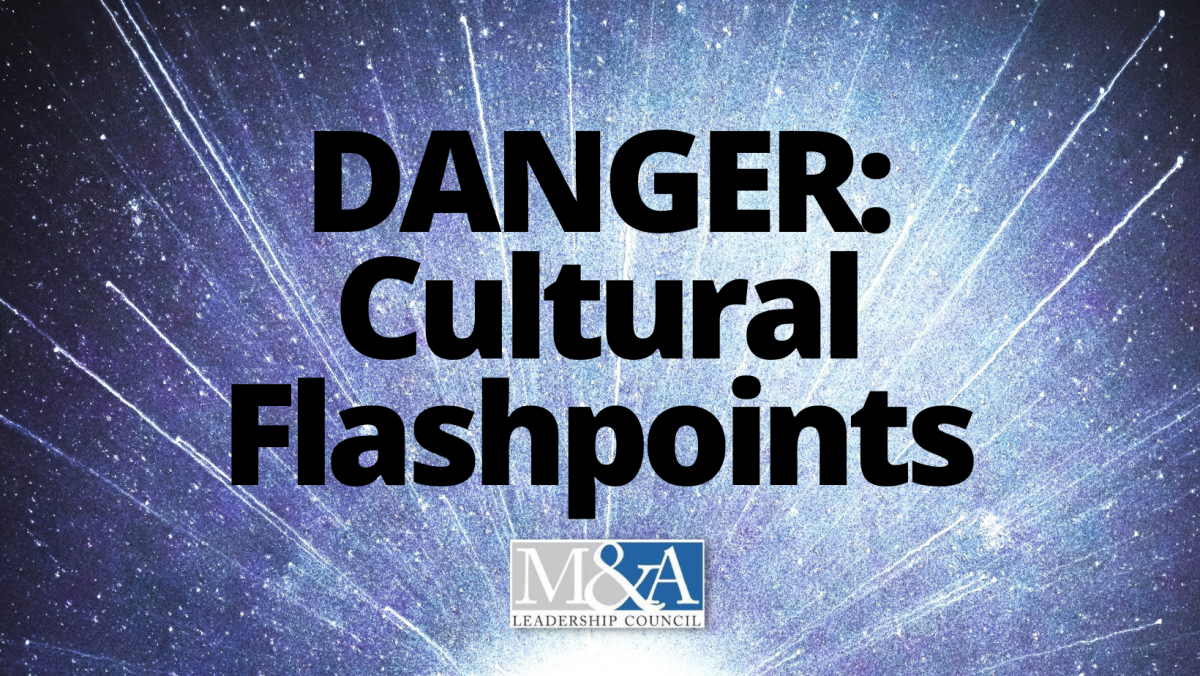
Don't Step on Cultural Land Mines in M&A
by Mark Herndon, Chairman Emeritus, M&A Leadership Council
In spite of all the ink, sweat and tears that have been devoted over the last twenty years to the topic of managing culture during M&As, the unfortunate reality is that most acquirers still aren’t very good at it. We’ll save a more comprehensive discussion of what culture is, how you discover it and what you do with it for a future blog. For now, let’s just start by helping you avoid the sometimes fatal and always costly mistake of stepping on cultural land mines, or as we like to call them, “cultural flashpoints.”
"We define cultural flashpoints as emotionally and historically significant traditions, most of which carry a disproportionate level of risk to very little synergy value.”
As this downloadable resource Caution Ahead – Cultural Flashpoints indicates, managing culture successfully during M&A is about achieving two absolutely essential business objectives:
First, is to minimize and avoid setting off cultural flashpoints.
Second, is to drive superior business results by defining and building cultural attributes proven to create high-performance.
Here’s the problem. Most acquirers unknowingly or unwittingly set off cultural flashpoints and self-inflict so much collateral damage that they must spend precious time, energy, and relationship capital, and focus getting back on track – all at a time when they can least afford this type of disruption.
We define cultural flashpoints as emotionally and historically significant traditions, most of which carry a disproportionate level of risk to very little synergy value. Unless your executive teams, deal teams and integration teams are prepared to deal with flashpoints, they are often not discovered until too late – when you’ve stepped on them and they blow up. When that happens the flashpoint becomes magnified, and you become demonized! Territorial battle lines get drawn and the inevitable “culture clash” serves as a divisive icon of how awful things have become.
Potential flashpoints abound. Here are a few of my favorites to watch out for…
- Branding, logos and acquired company names that are eliminated. As an example, search for the story about Nipper, the Jack Russell terrier listening to his master’s voice on a phonograph. This brand, used for many years by RCA Victor, is one of the most famous brand images of all time. A version of it is still in use today by U.K.-based entertainment retailer, HMV, over 100 years after the image was trademarked. You can imagine the dismay felt by customers and employees alike when this iconic image was substantially restricted over the course of multiple M&As and complex licensing requirements.
-
Employment perks and work-life benefits that are eliminated. I’m sure we can all recount some war stories on this one. Pizza lunches, happy hours, flexible work schedules, disparate types of tuition reimbursements, “movie night” (a story in itself!) and accrued but unused vacation time that gets wiped out. Yikes!
-
Customer impact of product or service rationalization. I can’t resist mentioning the all-time classic on this point, which we highlight in our book (Herndon, Galpin 2007). Years ago, when Union Pacific Corporation (UPC) acquired its 150-year-old rival, Southern Pacific Rail Corporation (SPRC) UPC made the entirely logical decision to rationalize SPRC’s rail routes and naming nomenclature to the “plain Jane,” alpha-numeric UPC naming conventions. The only problem was, they forgot about cultural flashpoints. For over 100 years Southern Pacific had cultivated a deep customer loyalty to their colorful and romantic rail routes such as the San Francisco Challenger, the Shasta Express, the Coast Daylight and the Memphis Blue Streak. As one Union Pacific manager lamented, “For Southern Pacific, losing the historic and emotionally significant Memphis Blue Streak – the company’s oldest and most famous line – it was tantamount to being betrayed, and betrayal is exactly what that decision was taken to be. We never recovered from that move.”
The message of cultural flashpoints, is NOT “don’t change.” Instead, the message is, “forewarned is fore-armed.” Look for flashpoints throughout due diligence and integration. Make smart integration decisions based on your insight into how people, organizations and customers respond to changes in historically or emotionally significant icons or benefits. And most importantly of all, plan and implement flawlessly using every proven change management and change leadership skill in your arsenal.
###
Learn more about the significance of culture in Diligence and Integration at our two upcoming in-person training events:
These sessions include face-to-face networking with presenters, peer interaction, small-group breakouts, team challenges, roundtable discussions and more. Join us!
The Art of M&A® for Due Diligence Leaders / In-Person / Boston, MA / Sep 2023 - September 12-14, 2023
The Art of M&A® for Integration Leaders / In-Person / San Diego, CA / Oct 2023 - October 11-13, 2023